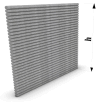Exploring the 3D Printability of Engineered Cementitious Composites with Internal Curing for Resilient Construction in Arid Regions
- PMID: 40731536
- PMCID: PMC12299853
- DOI: 10.3390/ma18143327
Exploring the 3D Printability of Engineered Cementitious Composites with Internal Curing for Resilient Construction in Arid Regions
Abstract
This study investigates the feasibility of pumice-based internal curing based on the 3D printability of engineered cementitious composites (ECCs) for water-scarce environments and arid regions. Natural river sand was partially replaced with the presoaked pumice lightweight aggregates (LWAs) at two different levels, 30% and 60% by volume, and 50% of the cement was replaced with slag to enhance sustainability. Furthermore, 2% polyethylene (PE) fibers were used to improve the mechanical characteristics and 1% methylcellulose (MC) was used to increase the rheological stability. Pumice aggregates, presoaked for 24 h, were used as an internal curing agent to assess their effect on the printability. Three ECC mixes, CT-PE2-6-10 (control), P30-PE2-6-10 (30% pumice), and P60-PE2-6-10 (60% pumice), were printed using a 3D gantry printing system. A flow table and rheometer were used to evaluate the flowability and rheological properties. Extrudability was measured in terms of dimensional consistency and the coefficient of variation (CV%) to evaluate printability, whereas buildability was determined in terms of the maximum number of layers stacked before failure. All of the mixes met the extrudability criterion (CV < 5%), with P30-PE2-6-10 demonstrating superior printing quality and buildability, having 16 layers, which was comparable with the control mix that had 18 layers.
Keywords: 3D-printed concrete (3DPC); engineered cementitious composites (ECCs); internal curing; lightweight aggregates (LWAs); printability; pumice; sustainability in construction.
Conflict of interest statement
The authors declare no conflicts of interest.
Figures















References
-
- Panda B., Tan M.J. Rheological behavior of high volume fly ash mixtures containing micro silica for digital construction application. Mater. Lett. 2019;237:348–351. doi: 10.1016/j.matlet.2018.11.131. - DOI
-
- Gomaa S., Irizarry E.M., Ahmed A., Rosa R.M., Ahmed H., Burroughs J., Kreiger E., Liu J., Troemner M., Cusatis G. 3D printing of ultra-high-performance concrete: Shape stability for various printing systems. Constr. Build. Mater. 2024;456:139039. doi: 10.1016/j.conbuildmat.2024.139039. - DOI
-
- Moelich G.M., Kruger J., Combrinck R. Plastic shrinkage cracking in 3D printed concrete. Compos. Part B Eng. 2020;200:108313. doi: 10.1016/j.compositesb.2020.108313. - DOI
-
- Van Der Putten J., Snoeck D., De Coensel R., De Schutter G., Van Tittelboom K. Early age shrinkage phenomena of 3D printed cementitious materials with superabsorbent polymers. J. Build. Eng. 2021;35:102059. doi: 10.1016/j.jobe.2020.102059. - DOI
-
- Uno P.J. Plastic Shrinkage Cracking and Evaporation Formulas. 1998. [(accessed on 1 April 2025)]. Available online: https://www.researchgate.net/publication/260209439.
Grants and funding
LinkOut - more resources
Full Text Sources
Miscellaneous

